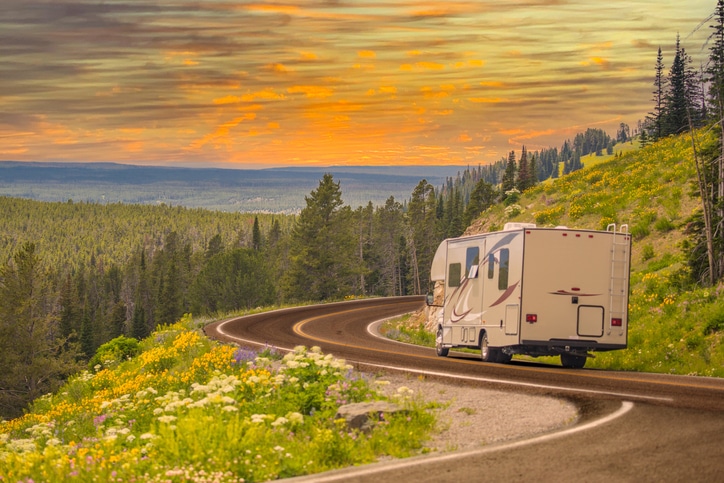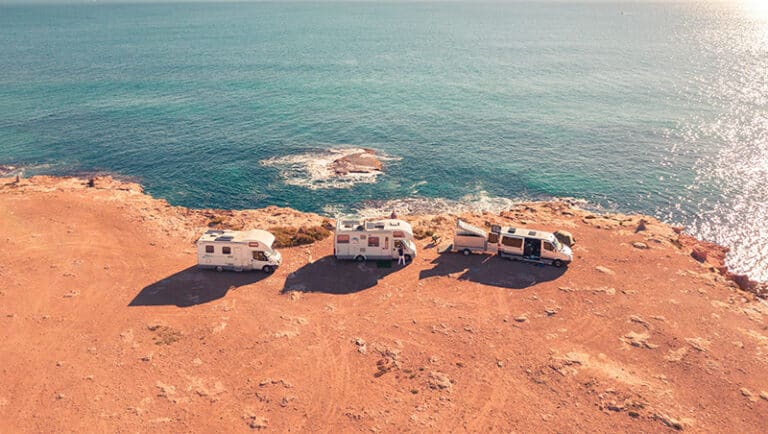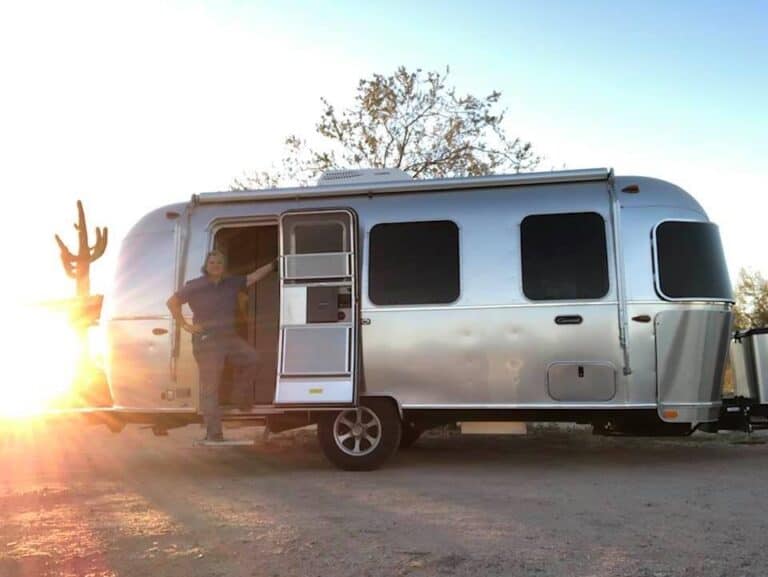6 Best Solar Panels for RV Living Off-Grid (2025)
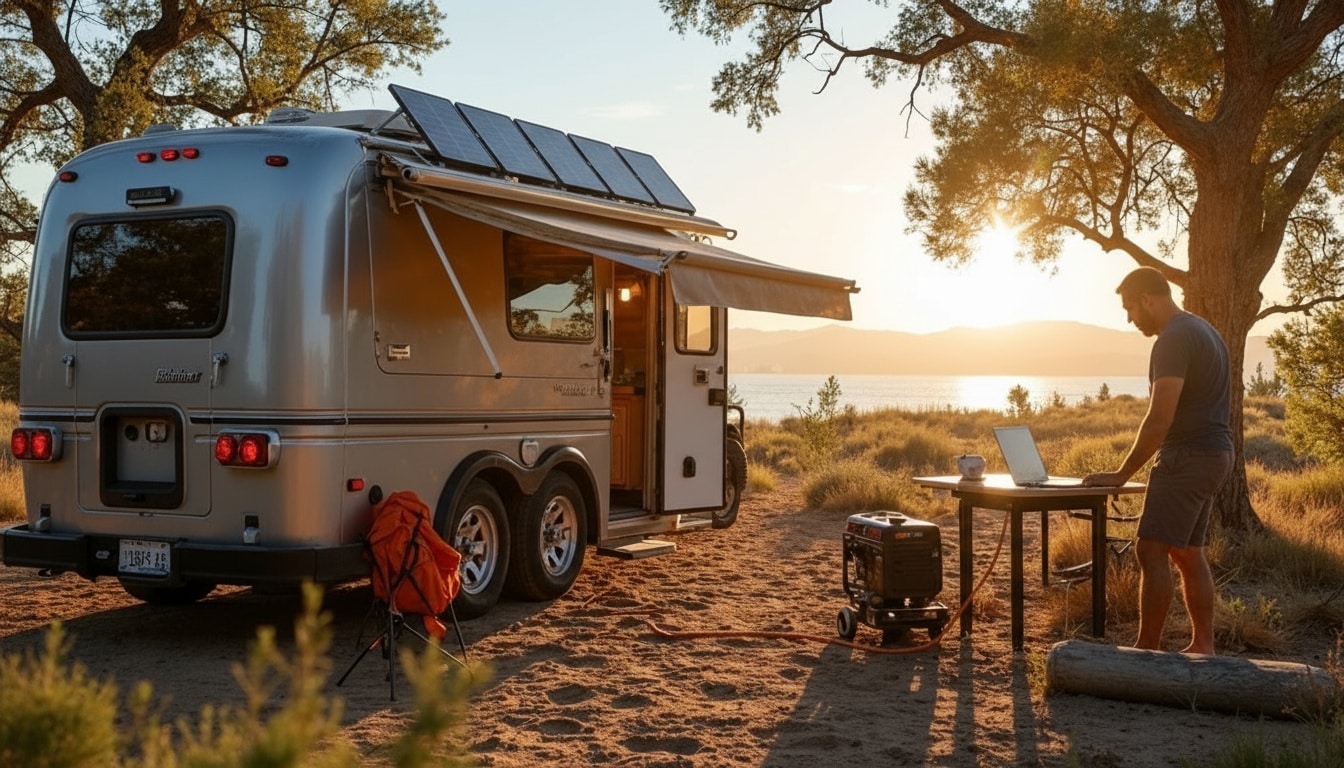
Living off-grid in your RV means freedom—freedom to camp where you want, work remotely from stunning locations, and wake up with nature as your backyard. But with that freedom comes a challenge: keeping your devices, fridge, and lights powered without plugging into shore power. That’s where solar comes in.
In 2025, RV solar technology is more affordable, efficient, and beginner-friendly than ever. Whether you’re a weekend adventurer looking for a simple portable panel, or a part-time nomad ready to invest in a full roof-mounted system, there’s a solar solution that fits your travel style and budget. In this guide, we’ll break down the best solar panels for RV living off-grid in 2025, comparing portable kits, roof-mounted systems, and expandable setups so you can hit the road with confidence—and plenty of power.

If you purchase through our partner links, we get paid for the referral at no additional cost! For more information, visit my disclosure page.
Why RV Solar Power Matters in 2025
In 2025, investing in RV solar isn’t just a nicety — it’s becoming essential. More and more travelers are seeking energy independence, especially digital nomads and weekend explorers who prefer peace and quiet over running a generator. The cost of solar has dropped significantly, while efficiency has improved, making it a viable alternative to noisy, fuel-guzzling generators. For RVers, that means more freedom, lower ongoing costs, and less reliance on campground hookups. The broader RV solar market is also booming — projected to more than double in value in the coming decade.
Weekenders, digital nomads, and full-time RVers alike benefit in different ways: weekenders enjoy silent power for lights and small devices, nomads can run laptops and routers off-grid, and full-timers can power fridges, fans, and more consistently. With scalable systems available, solar has become a dependable backbone to mobile living in 2025.
Comparing Portal vs. Roof Mounted Solar Panels
Deciding Between Portable vs. Roof-Mounted Solar Panels
Portable Panels
Portable solar kits—like those from Jackery or Goal Zero—are plug-and-play. You can set them on the ground, move them around to chase the sun, and store them when not in use. They’re especially handy for part-time RVers, weekenders, and boondockers who don’t want to drill holes in their roof or make a big upfront investment. The flexibility is a huge plus, but the tradeoff is that you need to set them up and pack them away each time, which can get old if you’re traveling full-time.
Roof-Mounted Panels
Roof-mounted solar systems—like Renogy’s 200W or 400W kits—are a better fit for long-term RVers or digital nomads who rely on steady charging. Once installed, they’re always working whenever the sun is shining, meaning you’re constantly topping off your batteries. The downsides? Installation requires time (or professional help), and you can’t easily tilt or move panels to chase the sun if you’re parked in shade. But for those who spend weeks off-grid or want “set it and forget it” convenience, roof-mounted is the way to go.
Portable vs. Roof-Mounted Solar Panels for RVs
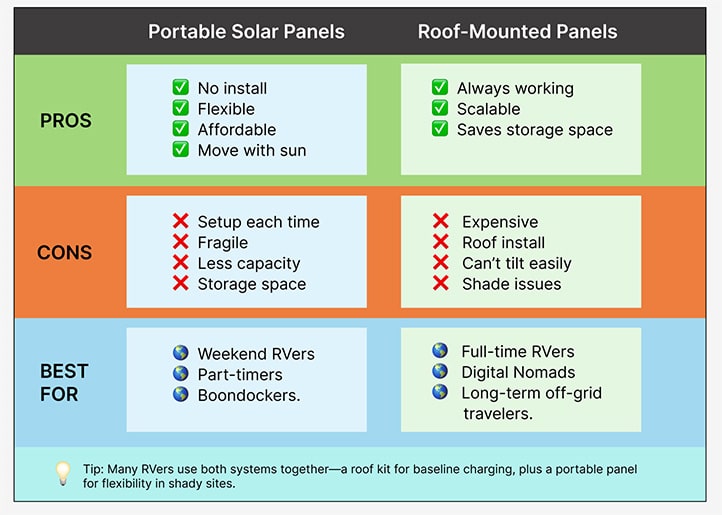
👉 Quick Tip for Readers: Many RVers start with a portable panel for flexibility, then add a roof-mounted system later as they spend more time off-grid. The combo offers the best of both worlds.
What are the Best Portable Solar Panels for RVs in 2025?
Why Choose Portable Panels
Portable solar panels are all about flexibility and ease of use. Unlike roof-mounted systems, they don’t require installation—just set them out when you need them and pack them away when you don’t. This makes them ideal for part-time RVers, weekend campers, or anyone who parks in shady spots where a rooftop system wouldn’t get enough sun. Because you can move them around, portable panels let you “chase the sun” throughout the day, maximizing efficiency. They’re also a budget-friendly way to get started with RV solar, with many high-quality kits available for just a few hundred dollars.
Top Picks for Portable Panels
1. Jackery SolarSaga 200W.
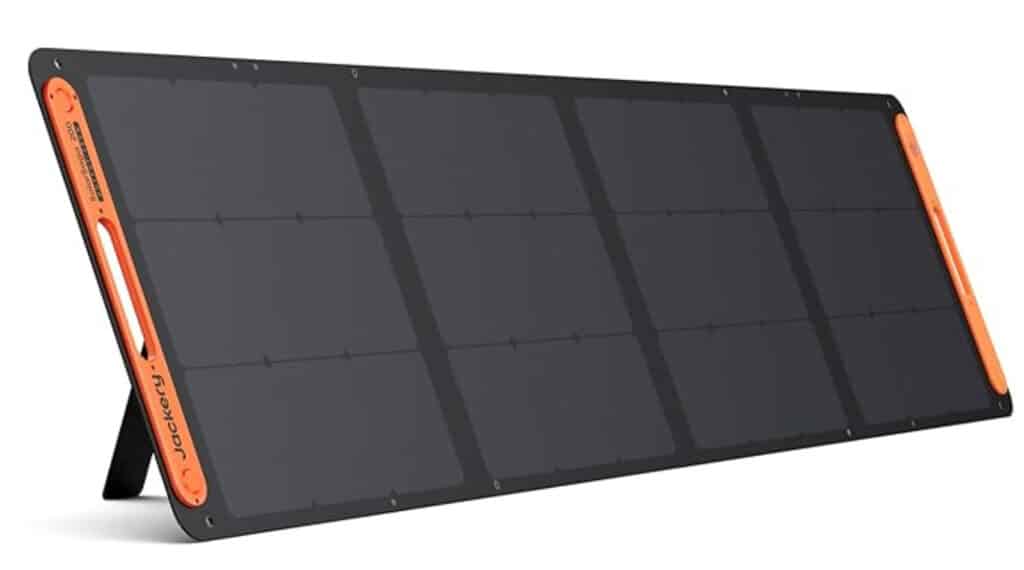
Jackery SolarSaga 200W
If you’re boondocking or need quick power on the go, the Jackery SolarSaga 200W panels fold into a briefcase-style carry case. Pair it with a Jackery Explorer battery for a plug-and-play solar setup.
- Pros: Extremely portable, no installation required
- Cons: Higher cost per watt, dependent on compatible batteries
2. Goal Zero Boulder 200 Briefcase Kit.
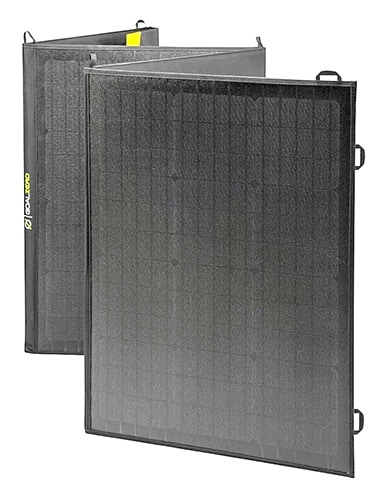
Goal Zero Boulder 200 Briefcase Kit
The Goal Zero Boulder 200 is rugged and reliable, built for frequent travelers who need strong output and durable gear. Great for camping, tailgating, or supplemental RV power.
- Pros: Heavy-duty build, good power output, folds for travel
- Cons: Pricey, heavier than Jackery’s panels
3. Renogy 200W 12V Portable Solar Panel Suitcase Kit.
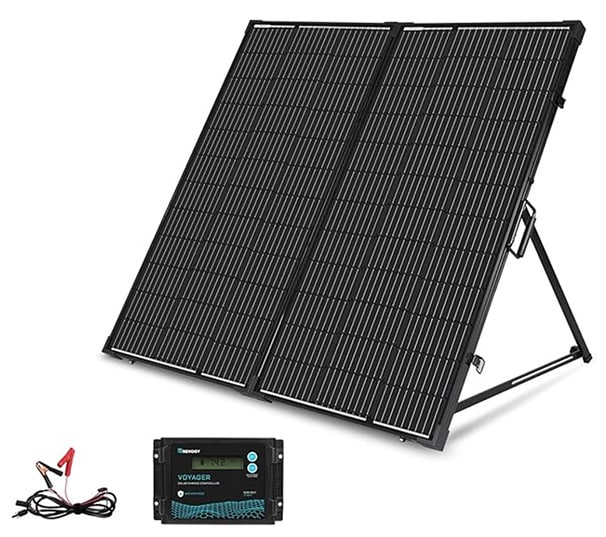
Renogy 200W 12V Portable Solar Panel Suitcase Kit
Plug-and-Play Solar Kit: This complete kit includes a 200W solar suitcase, a waterproof 20A Voyager charge controller, and alligator clips. Designed to be compatible with various 12V batteries, it seamlessly integrates into your existing system.
- Pros: Portable and Convenient, good power output, folds for travel
- Cons: Heavy and more storage space needed

Best Roof-Mounted Solar Systems for RVs
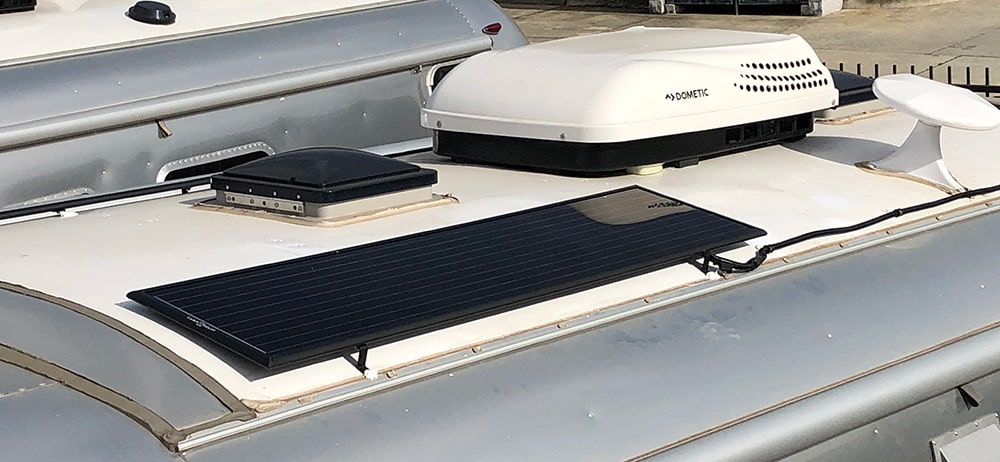
Why Choose Roof-Mounted Systems
After I bought my Airstream travel trailer, I went to a dealer to have them install the ZAMP solar legacy 200W panels on my curved roof. The installation came with a digital charge controller hooked up to my AGM batteries. I love having the roof top system, but when I’m parked in the shade the solar intake is limited. In the near future, I plan on upgrading my solar system to include a portable panel kit as well.
Roof-mounted solar panels are the set-it-and-forget-it solution for RV power. Once installed, they’re always working whenever the sun is shining—no setup, no storage, no extra effort. This makes them perfect for long-term travelers, digital nomads, or full-time RVers who rely on steady, reliable power every day.
Because they can handle larger systems (400W and up), roof-mounted kits are better suited for powering essentials like fridges, fans, and laptops around the clock. The biggest trade-off? You can’t move them to chase the sun so that shaded campsites will limit efficiency. But for those spending lots of time off-grid, the convenience, consistency, and scalability of rooftop systems make them a wise investment.
Top Roof-Mounted Kits for 2025
4. ECO-WORTHY 200 Watts 12 Volt/24 Volt Solar Panel Kit.
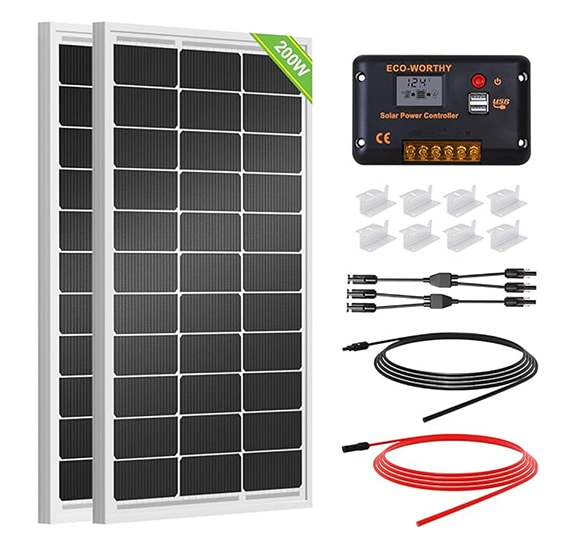
ECO-WORTHY 200 Watts 12 Volt/24 Volt Solar Panel Kit
ECO-WORTHY solar panels use high-performance monocrystalline solar cells. With two panels, a charge controller, and all the mounting hardware included, it’s ideal for RVers who want reliable energy without a complex install.
Pros: Corrosion-resistant aluminum alloy frame, so that the panel can be used for decades, and can withstand strong winds.
Cons: Roof-top install is less flexible.
5. Renogy 400W All-in-One Kit.

Renogy 400W All-in-One Kit
For digital nomads who need to run multiple devices, lights, and even appliances, the Renogy 400W kit delivers serious juice. It’s a roof-mount system for those ready to invest in long-term solar independence.
- Pros: High output, expandable, excellent for extended stays
- Cons: Installation required, higher upfront cost
6. Zamp Solar Legacy Series 90-Watt “Long” Roof Mount Solar Panel Kit.
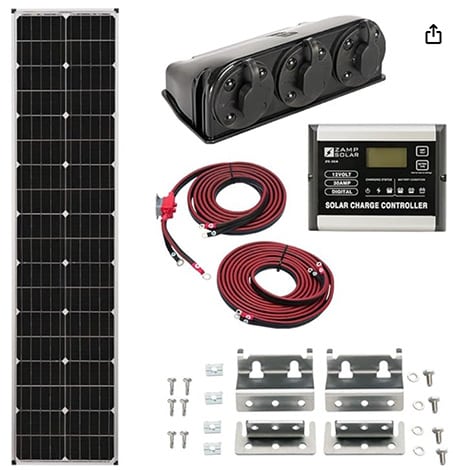
Zamp Solar Legacy Series 90-Watt “Long” Roof Mount Solar Panel Kit
Long and narrow (58.3 inches x 13.6 inches x 1.5 inches); Special feet for curved roofs (Airstreams) ; Easy installation; Best-in-class solar cells Charges most types of 12-volt batteries, including lithium
- Pros: Lightweight, flexible mounting, Handcrafted in the USA; 25-year output warranty
- Cons: Lower wattage, may need multiples for higher power needs
Buying Guide: How to Choose the Best RV Solar Setup
1. Calculate Your Power Needs
Start by listing the essentials you’ll run daily: laptop, fridge, lights, fans, Wi-Fi router, etc. Add up their watt usage and multiply by the hours you expect to use them. For example, a laptop that pulls 60W for 5 hours = 300 watt-hours. This math helps determine whether a 100W panel will cut it, or if you need a 400W setup.
How Much Solar Power Do I Need for My RV? (Simple Answer)
If you’re just getting started, don’t overthink it—most RVers need enough solar to cover their daily essentials (lights, fridge, phones, laptops, Wi-Fi). A 200–400-watt solar panel setup with a 100–200Ah lithium battery is usually plenty for weekend or part-time RVers. If you’re planning to work remotely full-time, run a 12V fridge, and keep multiple devices charged, think bigger—closer to 400–600 watts of panels and 200–300Ah of batteries.
The good news: solar is modular. You can start small (say, a portable suitcase panel) and expand as you learn how much power you really use. Almost every RVer adds panels and battery capacity after their first season, once they know their routine.
Try out Go Power!’s Solar Calculator, select your RV type, battery and appliances, then it offers a few products to meet your needs : Go Power Solar Calculator. And if you like to do things yourself, the YouTube Channel: RVing with Tito DYI, might be helpful as well.
2. How to Factor in Budget & Expandability
Solar is one of those RV upgrades where you’ll want to balance what you can afford now with how your needs may grow later. A small portable panel system can be had for around $200–$300, and it’s often enough for weekend trips or topping off batteries when you just need to charge lights, phones, and small devices. On the other end of the spectrum, a full rooftop kit with multiple panels, batteries, and an inverter can easily reach $1,000–$2,000+, but it provides the convenience of always-on charging and enough power to support remote work or extended off-grid living.
When planning your system, think about expandability. Do you want to “start small and scale up,” or go all-in at once? Many RVers begin with one or two portable panels and later add roof-mounted solar or extra batteries as they learn more about their power usage. Kits like Renogy’s solar systems are modular, meaning you can add panels or upgrade batteries over time without scrapping your original setup. This way, your solar investment grows with you and your travel style.
👉 Tip: Even if you’re on a budget, choose equipment (charge controllers, inverters, batteries) that can handle more capacity than you need right now. That makes upgrading much smoother later.
Comparison Table: Best Solar Panel Options for RVs
| Product | Best Use Case | Key Specs / Features | Price Estimate* | Recommended For |
|---|---|---|---|---|
| Renogy 100W Flexible Solar Panel | Lightweight, flexible setups (roof or curved) | 100 W, bendable, easy mounting | ~$126 – $139 | Small rigs, minimal weight add-up |
| Renogy Starter Kit N-Type 200W 12V Solar Kit | Roof-mounted full panel solution | 200 W panel + charge controller + mounting kit | ~$199 – $220 | Mid-size RVs with roof space |
| Jackery SolarSaga 200 | Portable backup, supplemental gain | 200 W foldable, portable, off-grid ready | ~$378 – $389 | Boondocking, campsites without hookups |
| Goal Zero Boulder 200 Briefcase Kit | Foldable panel + portability | 200 W dual-panel foldable array | ~$599 | Travel setups that need flexibility |
| Renogy 400W All-in-One Kit | High output rooftop solution | Four 100W panels + controller, all-in-one kit | ~$459 – $579 | Larger RVs, power-hungry setups |
*Prices are estimates for reference—check sites for current offers.
Power Stations & Backup Batteries: The All-in-One Solar Generator Choice
When you want plug-and-play power, a solar generator (or portable power station) offers one of the most elegant solutions for RVers. These units combine battery, inverter, and often solar input protection into a single box, reducing wiring complexity and letting you power AC devices without tons of additional gear. For people who travel lightly or want convenience, a good solar generator can bridge the gap between portable solar kits and full rooftop systems.
Here are three standout options popular with RVers in 2025:
Jackery Explorer Series
Jackery’s Explorer 1000 v2 power station are widely used in the RV community because they’re dependable, modular, and easy to use. Each unit includes AC outlets, USB ports, and MPPT input. You can pair them with Jackery’s foldable solar panels for seamless integration. They’re great for laptop use, small appliances, and nighttime power needs—for people who don’t want to fuss with complicated setups.
Bluetti AC200Max
The Bluetti AC200Max Portable Power Station is a more powerful option built for people who run heavier loads in their rigs. With a high-capacity battery (~2,048 Wh) and a robust 2,000W pure sine inverter, it can handle things like microwaves, power tools, or AC (in moderation). It supports expansion with extra battery modules and solar input, making it a flexible choice for part-time or full-time nomads who want one heavy-duty unit rather than many smaller ones.
Goal Zero Yeti Series
Goal Zero Yeti Portable Power Station is a longtime name in adventure power, and their Yeti line (especially models like the 1500X) offers a mix of reliability and brand trust. They’re well suited for weekenders or mid-level usage. The Yeti units generally strike a balance between portability and capability—perfect for powering devices like routers, lights, and laptops while camping, with enough AC capacity for small appliances.
✅ Tip for Choosing:
Match your power station to your peak loads (e.g., how many watts you’ll run at once) and daily draw (total watt-hours). If your devices rarely exceed 500W at a time, a mid-tier Explorer or Yeti may suffice. But if you expect to run AC, coffee makers, or small appliances regularly, a more robust unit like the AC200Max or pairing multiple units is safer.
Smart Power Management Tools Every RVer Needs
When you’re living or traveling in an RV, having solar panels is only half the equation. To get the most out of your setup, you’ll want a few smart power management tools that make your energy system more efficient, reliable, and easy to monitor.
Inverter Upgrades
An inverter turns your stored DC battery power into AC electricity so you can run everyday items like laptops, coffee makers, or even a microwave. Many RVs come with basic inverters, but upgrading to a pure sine wave inverter gives you cleaner, more reliable power—especially important for sensitive electronics like laptops or medical devices.
- Victron Multiplus 12/3000W Pure Sine Inverter — reliable, scalable, with built-in battery charger and power assist mode.
- Renogy 3000W Pure Sine Wave Inverter — good mid-range choice for part-time users who need extra surge capacity.
MPPT Charge Controllers
If you’re investing in solar, a Maximum Power Point Tracking (MPPT) charge controller is a must. It’s the brain of your solar system, optimizing the flow of electricity from your panels to your batteries. Compared to older PWM controllers, MPPTs can boost efficiency by up to 30%, meaning more usable power from the same panels—a big deal if you’re often boondocking or running off-grid.
- Victron SmartSolar MPPT 150/70 — Bluetooth monitoring, high efficiency, and handles large array/button expansion.
- Renogy Rover 60A MPPT — budget-friendly but solid performance, with features like temperature compensation and load control.
Battery Monitors
Guessing how much battery you have left can cut a trip short. A battery monitor takes the mystery out by giving you real-time information on your power use, battery health, and remaining charge. Some models sync with your phone via Bluetooth, letting you check your system from anywhere in your rig. This not only prevents surprises but also helps you manage energy wisely, especially when working remotely or camping for days off-grid.
- Victron BMV-712 Smart Battery Monitor — complete diagnostics, Bluetooth app, high accuracy and reliability.
- Renogy 500A Battery Monitor — simple, cost-effective, with a real-time monitor of voltage, current, and battery state.
FAQs about Solar Power for my RV
“How much solar power do I need for my RV?”
Most part-time RVers can get by with 200–400 watts of solar, which is enough to power laptops, lights, fans, and small appliances. Full-time RVers who want to run fridges, TVs, or multiple devices often need 600–1,000 watts or more. Start small with an expandable kit if you’re unsure.
“Are portable solar panels worth it for RVs?”
Yes — portable solar panels are ideal for digital nomads and weekend travelers. They fold up for easy storage, don’t require permanent installation, and let you chase the sun even when your RV is parked in the shade. However, they may not produce as much power as roof-mounted systems.
“What’s the difference between portable and roof-mounted RV solar?”
Portable panels: Lightweight, flexible, no installation, but require setup each time.
Roof-mounted panels: Provide consistent charging while driving or parked, higher output, but need permanent installation.
The best option depends on how often you travel and how much power you use.
“Can I install RV solar panels myself?”
Yes, many RV solar kits are DIY-friendly, especially starter kits from brands like Renogy. Portable panels require almost no setup. Roof-mounted systems are more involved but still manageable for handy RVers. If wiring to batteries or inverters feels intimidating, you can always hire a pro installer.
Conclusion: Powering Your RV Life With Solar
Choosing the proper solar setup for your RV comes down to how you travel, your budget, and whether you want a flexible starter system or a full-time energy solution. Portable panels are perfect for weekenders and first-timers, while roof-mounted systems deliver reliable power for long-term nomads. No matter which path you take, investing in solar gives you freedom, independence, and the peace of mind that your adventures won’t be cut short by a dead battery.
Recommended Solar Gear for RVers
🌞 My Favorite Portable Solar Panels for RVs
I like these because they’re plug-and-play, super lightweight, and perfect for weekend trips. You can set them up in minutes and chase the sun all day.
👉 My pick is the Goal Zero Boulder 200 Briefcase Kit🔋 Roof-Mounted Solar Kits
For RVers ready to go all-in, Eco-Worthy rooftop kits are a great choice. They’re modular, reliable, and expandable if you want to add more panels later.
👉 My pick is the ECO-WORTHY 200 Watts 12 Volt/24 Volt Solar Panel Kit⚡ Backup Power Stations (Jackery & Goal Zero)
Even if you have roof panels and batteries, If you’re going to be off-grid, I always suggest a backup power station. These double as portable chargers and can run laptops, CPAPs, or even a small fridge.
👉 My pick is Jackery’s Explorer 1000 v2 power station
✉️ Join the Travels with Wally Newsletter
Adventure, gear tips, and off-grid stories—straight to your inbox.
Want more RV guides, travel inspiration, and insider gear reviews? Subscribe today and get the best of Travels with Wally delivered to you twice a month.



